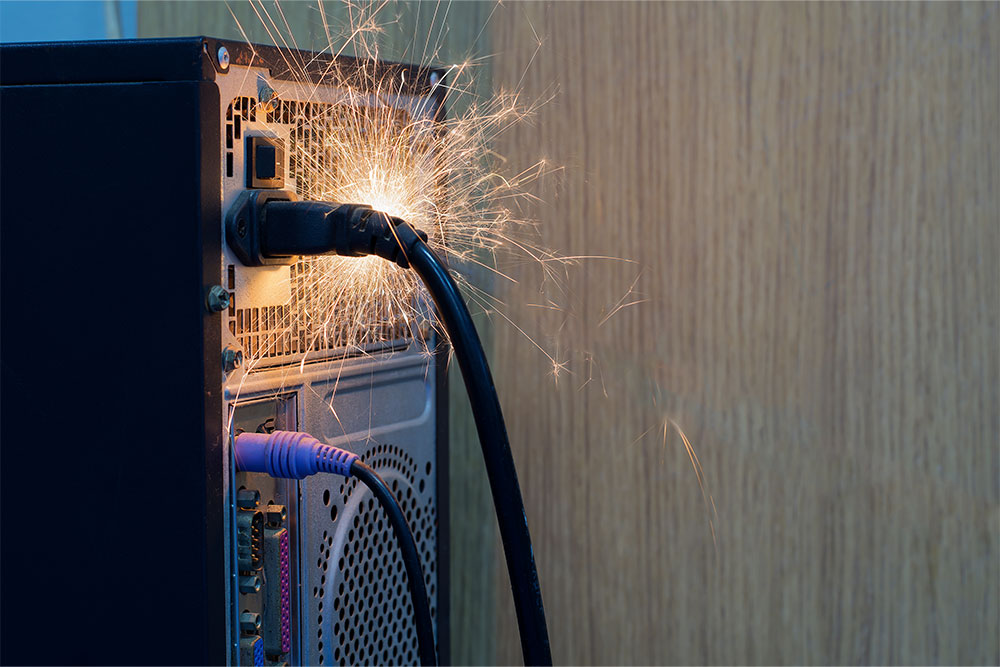
Electricity is a fire risk. If any appliance, plug, cable or socket is faulty or misused, it can spark or overheat, causing an electrical fire. If this happens, you have moments to handle it before the fire spreads, so it pays to know how to put out an electrical fire.
This guide will walk you through the necessary steps and precautions for tackling these emergencies. It also explains how to prevent electrical fires and what firefighting equipment you need in the workplace.
How Common are Electrical Fires?
Electrical fires happen when electrical equipment or appliances (plus their leads, cables and plugs) are faulty or misused.
Anything with an electrical current flowing through it is at risk of overheating. This can be caused by an internal fault or overloading (where more power is drawn from a socket than it can safely handle.)
Because electrical equipment is so commonplace, it’s a leading cause of fires.
During 2023/24, there were 24,086 primary fires in England. Of these fires, 3,486 were caused by faulty appliances or leads, and 7,051 resulted from the misuse of appliances or equipment. That means almost half of all fires were linked to electrical equipment in some way.
How to Put Out an Electrical Fire
There are five fire classes defined by fuel source. Each class of fire burns differently and requires a different type of extinguisher. The five classes of fire are:
- Class A – combustible materials such as paper, wood or fabric
- Class B – flammable liquids such as petrol or motor oil
- Class C – flammable gasses such as methane or butane
- Class D – burning metals such as lithium or aluminium
- Class F – burning fats or cooking oils
Electrical fires are an outlier. There’s no Class E because electricity doesn’t burn, so it isn’t strictly a fuel source. Instead, it provides the heat for ignition.
But you still need specific equipment to put out an electrical fire safely.
Should I Use Water?
Never use water to put out an electrical fire. Water conducts electricity, so pouring it on electrical equipment risks spreading the fire further and causing an electric shock.
For the same reason, you must not use a water extinguisher.
What Extinguisher Should I Use?
Use a carbon dioxide (CO2) extinguisher to safely put out an electrical fire. Carbon dioxide displaces oxygen to choke the fire out without any risk of conducting the electrical current.
You can also use dry powder extinguishers on electrical fires, although they’re not as effective as their CO2 counterparts.
Here’s a step-by-step guide:
- Cut the Power Supply: If it’s safe, cut the power to the affected area or appliance. This eliminates the risk of electrocution and can prevent the fire from spreading.
- Use the Appropriate Fire Extinguisher: Aim the CO2 or dry powder extinguisher at the base of the fire. Follow the PASS technique: Pull the pin, Aim the nozzle, Squeeze the handle and Sweep from side to side.
- Contact the Emergency Services: If the fire cannot be controlled safely, evacuate the area and call the emergency services immediately.

What If I Don’t Have the Right Extinguisher?
Not having the right extinguisher shouldn’t be an issue in the workplace. Under the Regulatory Reform (Fire Safety) Order 2005, all workplaces should be equipped with appropriate extinguishers, and those extinguishers must be regularly inspected and maintained in safe working order.
What’s appropriate is settled by your fire risk assessment. But if electrical equipment is used in your workplace, you should have carbon dioxide extinguishers on hand.
There should be enough extinguishers spread throughout your workplace so that in an emergency, no one has to travel further than 30m to retrieve one.
But, if you’re pressed for time, or the extinguisher you grab isn’t working, you do have other options.
You can smother a small electrical fire with a fire blanket. Fire blankets are designed to be used against Class F fires, so they’re routinely found in workplace or commercial kitchens. Kitchens are also hotspots for electrical appliances, so a fire blanket might be your best option for tackling a small electrical fire quickly.
As a last resort, you can also dump bicarbonate of soda (or baking powder, which has similar ingredients) on an electrical fire to smother it.
Do not use flour. Some people maintain this will have the same effect, but flour is flammable. Pouring it on a fire will only make it worse.
Always use a carbon dioxide extinguisher whenever possible. It is more effective and safer than any improvised method.
How to Prevent Electrical Fires
Fire prevention is always the preferred option. Learning how to put out an electrical fire should come second to learning how to prevent one.
Good Housekeeping
Keep electrical appliances clean, particularly those in the kitchen. Crumbs, grease and oil can all build up and cause appliances to burn.
Good housekeeping is also necessary to keep evacuation routes clear and firefighting equipment accessible.
Electrical Safety
Follow instructions and avoid overloading sockets, which can lead to overheating and fires.
Before using any electrical equipment, perform a visual inspection to spot any obvious defects. Smoke, strange noises, unusual smells, scorch marks or spotty performance are all indicators of a fault. Never use an appliance showing these warning signs, even if it appears functional.

Portable Appliance Testing
Portable appliance testing (PAT) is an effective method to ensure electrical safety. Arrange for your equipment to be tested regularly by a trained operative. PAT helps identify electrical faults before they become hazards.
Fire Safety Training
Provide fire safety training to your employees. Raise awareness of common electrical fire hazards and fire prevention strategies. Training can also cover extinguishing fires, so staff can learn how to put out an electrical fire without any stakes.
How to Put Out an Electrical Fire – Key Takeaways
- Use a carbon dioxide extinguisher to put out an electrical fire. Dry powder extinguishers can also be used but are less effective.
- Disconnect the power supply if it’s safe to do so before attempting to extinguish an electrical fire.
- Use a fire blanket or bicarbonate of soda as a last resort if you don’t have the appropriate extinguisher,
- Ensure your workplace is equipped with the correct fire extinguishers and conduct regular firefighting equipment inspections and training.
Fire Extinguisher Training
All fires, particularly electrical fires, need specific extinguishers. If your carbon dioxide extinguishers aren’t regularly inspected and maintained, you won’t be able to tackle an electrical fire safely. You’ll also be in non-compliance with the Fire Safety Order.
Our online Fire Extinguisher Inspection Training explains how to fulfil your inspection duties. This multi-module course covers all types of extinguishers and inspection procedures. It helps ensure compliance with fire safety regulations and confidence your fire extinguishers are waiting in safe working order.






















































































































































































































































































































































































































































































































































































































































































































































